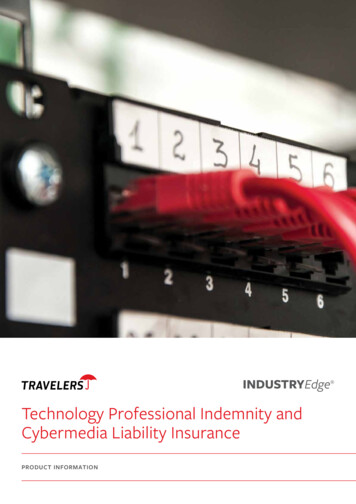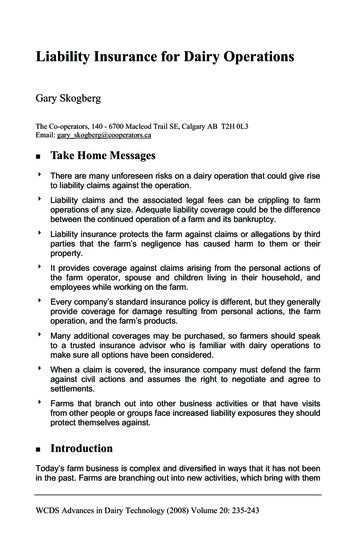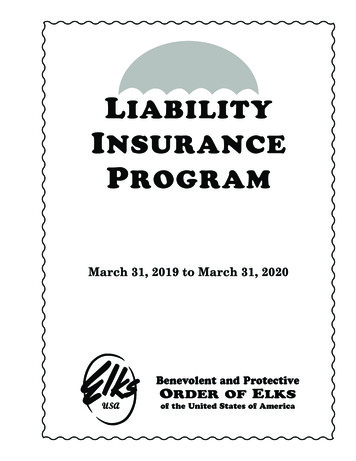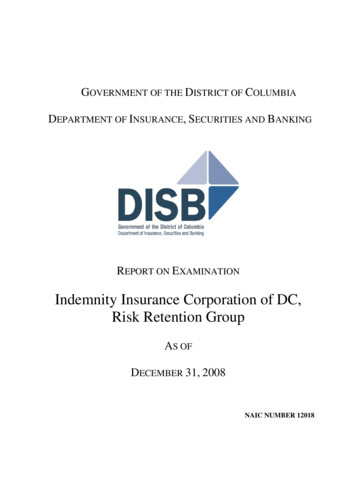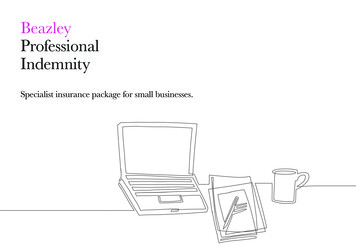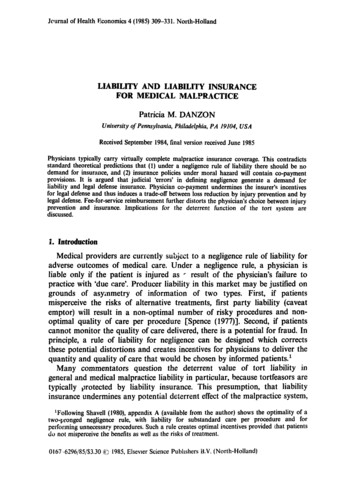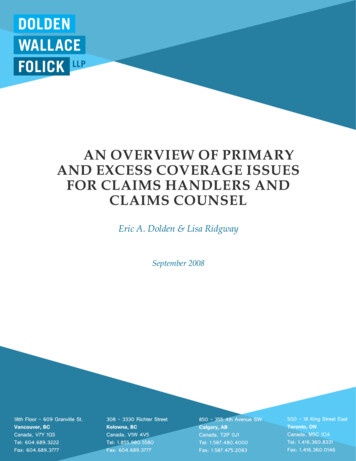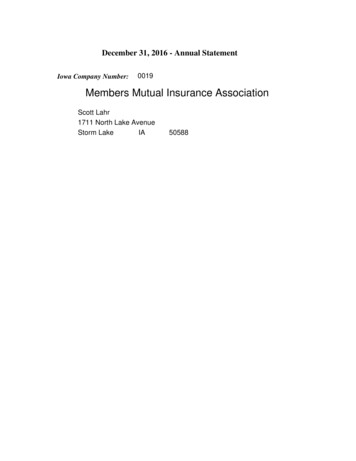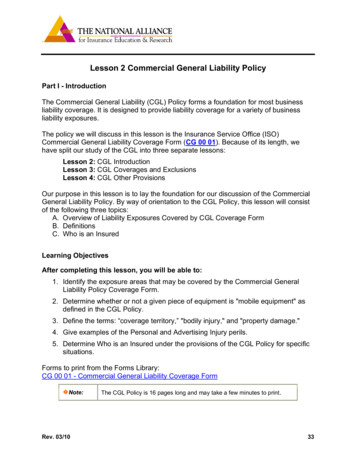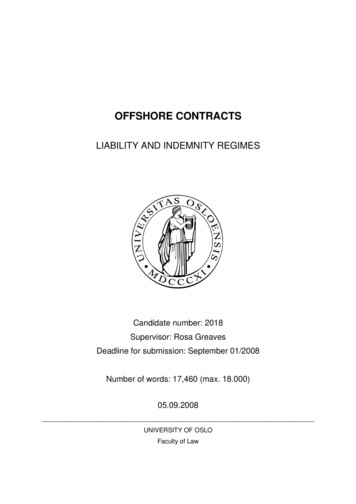
Transcription
OFFSHORE CONTRACTSLIABILITY AND INDEMNITY REGIMESCandidate number: 2018Supervisor: Rosa GreavesDeadline for submission: September 01/2008Number of words: 17,460 (max. 18.000)05.09.2008UNIVERSITY OF OSLOFaculty of Law
ContentCHAPTER 1INTRODUCTION1CHAPTER 2OVERVIEW OF THE REGULATORY FRAMEWORKS42.1United Kingdom’s licensing system42.2Norwegian Oil and Gas Industry82.3Oil and Gas Industry in Brazil102.4Defining a contracting strategy12CHAPTER 3STANDARD CONTRACTS163.1Why standardizing agreements163.2Standard contracts – Norway, UK and Brazil17CHAPTER 44.1ALLOCATION OF RISKSThe knock-for-knock principle19194.1.1Loss and damages204.1.2Third Party claims264.2Industry mutual hold harmless284.3The exclusion of gross negligence and willful misconduct.314.4Drafting Effective Indemnities Provisions324.4.1Basic structure of an indemnity provision324.4.2Overall cap36I
4.5Liabilities and indemnities provisions in standards agreements4.5.137LOGIC - Standard Contract - Construction - Edition 2 (UK) – Liabilities and Indemnities Clause384.5.2NF 07– Liability clause434.5.3PNBV Contract – Liability clause50CHAPTER 5CONCLUSION56ABBREVIATIONS AND DEFINITIONS 59LIST OF SOURCES 60LIST OF ANNEXES AAnnex I - Logic contractBAnnex II - NF/07CAnnex III - PNBV ContractDAnnex IV - IMHH DeedEII
CHAPTER 1 INTRODUCTIONThe development phase of an offshore oil field involves a series of contracting activitieswhich are no less complex than the projects themselves. Along the years, this has lead toan area of expertise for the legal community in the oil and gas industry worldwide.A good illustration of this is the evolution over the years of the oil companies procurementstrategy for procurement of offshore installations.With ever-improving technologies available subsurface, subsea and on the processingfacilities themselves, the complexity and magnitude of these projects for procurement ofoffshore installations have increased dramatically. In order to cater for this increasedcomplexity and magnitude (involving several contractors, subcontractors, suppliers, subsuppliers etc) the industry has developed the so-called EPC (Engineering, procurement andconstruction) and EPIC (Engineering, procurement, installation and commissioning) typesof contracts.The main objective of those forms of contracts was to simplify the contracting process,creating a single point of responsibility and to reduce as much as possible the interfaces andmanagement between engineering, procurement and construction activities. A secondaryobjective, but no less important, was a will to reduce the overall delay between oildiscovery and start of production, thus increasing the economic profitability of thosemassive offshore projects.In order to achieve the above and to avoid time-consuming negotiations, significant workand efforts were invested so as to define a fair balance between contracting parties bydesigning standard agreements. This was first done by the oil industry in Norway with1
edition of The Norwegian Fabrication Form1, followed-up in the United Kingdom – Thestandard contracts for UK offshore oil and gas Industry2, both of which will be detailedfurther in this dissertation and the creation of the industry mutual hold harmless scheme inthe United Kingdom continental shelf.Central to this dissertation will be the liabilities and indemnities regimes adopted in thosestandard agreements, particularly the allocation of risks for (i) loss and damages to propertyowned by each contracting parties, (ii) personal injuries, death or illness of personnel, (iii)indirect or consequential losses and (iv) third party claims arising out of personnel injuries,illness or death, or property loss or damages suffered by third parties. The knock-for-knockprinciple and mutual hold harmless scheme will be introduced as these are the central legalpieces of the contracts supporting offshore installations projects.As will be addressed in this dissertation, the knock-for-knock principle and mutual holdharmless scheme have created by virtue of agreements a special liability regime whichdiffers from what would normally be provided by each respective legal systems andstatutes.This dissertation will also describe the liability regimes adopted in Brazil by the stateowned oil company Petroleo Brasileiro SA – Petrobras in the so called “PNBV Contract”.Firstly, because as a counter-example to the regimes developed in the North Sea3, itillustrates perfectly the main principles. Secondly, recent new oil field discoveries (2007)on the Brazilian continental shelf are extremely promising for the oil and gas industry, withexpectations to require a significant portion of all world-wide new (or refurbished) offshoreinstallations for the next 10-20 years.1The Norwegian Fabrication Form was originally edited in 1992 and subsequently reviewed. Last editionpublished in 2007.2Formerly Crine Standard Contracts. See further in chapter 3.2.3The North Sea connects with the rest of the Atlantic through the Dover Strait and the English Channel in thesouth and through the Norwegian Sea in the north.2
It will also be reviewed the position at English law in respect to the effectiveness ofliabilities and indemnities provisions, in particular, the cases derived from the Piper Alpha4disaster, which have opened high level discussions on the enforcement of such provisions.Based on those English law cases it will be present some considerations of how to drafteffective liabilities and indemnities provisions.The main focus of this dissertation is to identify the differences between liability regimesused in Norway, UK and Brazil. This in turn will be of assistance for Contractors tocorrectly identify the level of liability they may be exposed to when performing services inthese three countries.The issue concerned with applicable local laws will not be central for this dissertation asmost of those contracts (except the NF07 one) do provide the English Law as the governinglaw to solve any disputes that may result from the contract execution. However, theexperience of the English courts will be discussed as a general guideline of how to drafteffective liabilities and indemnities provisions.Finally, it is relevant to remark that when responsibilities and liabilities are split betweencontracting parties, the insurance regime also needs to be taken into consideration. It wasout with the realm of this dissertation to address in depth the insurance schemes and theassociated risk allocations linked to such schemes. It is however suggested that thisdissertation and its structure can be used as a basis and reference point for such analysis.Therefore, this dissertation will focus on the legal contractual aspects only.4See further herein chapter 4.1.13
CHAPTER 2 OVERVIEW OF THE REGULATORY FRAMEWORKSPrior to entering into the main subject of this dissertation, this chapter will give anoverview of the regulatory frame works for the oil and has industry in UK, Norway andBrazil.2.1United Kingdom’s licensing systemThe oil and gas industry in the UK is based on a licensing system controlled andadministrated by its Department for Business, Enterprise and Regulatory Reform (the“BERR”).The Petroleum Act 1998, which is the master regulation in the UK oil and gas sector, vestsin the Crown the exclusive rights to search for, bore and for and get petroleum in theUnited Kingdom Continental Shelf5. However, the Secretary of State for the DepartmentBusiness, Enterprise and Regulatory Reform (BERR)6, hence the Government has thepower to grant licences that confer exclusive rights to "search and bore for and get"petroleum to a private party7.The UK Continental Shelf (UKCS) comprises those areas of the sea bed and subsoilbeyond the territorial sea over which the UK exercises sovereign rights of exploration andexploitation of natural resources. The exact limits of the UKCS are set out in orders made5See further. Petroleum Act 1998. 2. Rights to petroleum vested in Her Majesty (2).The Energy Department Unit (part of BERR s Energy Command) is responsible for licensing explorationand regulation development of UK s oil and gas resources.7See Further. Petroleum Act 1998. 3 Licences to search and bore for and get petroleum (1).64
under section 1(7) of the Continental Shelf Act 1964. In addition, agreements to divide thecontinental shelf according to the median line principles8 were concluded between Norwayand UK in March 19659.The process to grant these licences involves close examination of the technical andfinancial capacity of these private parties by the BERR. The applicants for a licence(private party) shall first submit a proposal to the BERR, which will be reviewed andselected in a licence round process. The rights granted by those licences will be limited toa specific area and for a limited number of years.Licences are very similar to contracts in their format, but they also contain many regulatoryelements. The rights and obligations regulating the relationship between Government and aprivate party (licensee) are described in the licence and are also set forth in the ModelClauses. The Petroleum Act requires that such regulatory conditions – Model Clauses10 –be first published in a secondary legislation.In summary the seaward licensing system consists of 2 main types of licences: (i)Production Licences and (ii) Exploration Licences. Production Licences are the main typeof seaward licence and despite their name they cover the entire life of an oil field fromexploration to decommissioning. In an effort to promote new entrants in the UK sector, andmaking the UKCS an attractive business to smaller oil companies, the Government hasintroduced 3 variations of the Traditional Production Licence, such as Promote Licences,Frontier Licences and Licences specially drafted to cover the redevelopment of adecommissioned field. One of the main attractive differences between these new licencesand the traditional licences is that the new ones provide more flexibility in terms of8The median line is the line every point of which is equidistant from the nearest points on the baselines fromwhich the breadth of the territorial seas of the neighboring states measured.9Petroleum law compendium / Nordisk institutt for sjørett. - Oslo: Instituttet, 2003. – Book 1. pag. 910 The model clauses currently in use for Seaward Production Licences can be inspected on the OPSI (Officeof Public Sector Information) website at the Petroleum Licensing (Production) (Seaward Areas) Regulations2008 (2008/225). Those used for Landward Production Licences and for Seaward Exploration Licences are atthe Petroleum Licensing (Exploration and Production) (Seaward and Landward Areas) Regulations 2004 (No352)5
minimum work obligation the licensees have to commit to in the initial term of the licence(i.e. exploration).The second main type of licence is the Exploration Licence. It is suitable for companiesperforming exploratory surveys over wide areas of the offshore sector. The rights grantedby the Exploration Licence are neither exclusive nor limited to a specific area. It can thuscover any location within the UKCS, as well as allow exploration within an area alreadycovered by an existing Production Licence. However, in this last case, an agreement withthe holder of the particular Petroleum Licence will be required.According to the information displayed on the BERR website11: The UK’s licensing systemcovers oil and gas within Great Britain, its territorial sea and on the UK Continental Shelf(UKCS). Northern Ireland's offshore waters are subject to the same licensing system as therest of the United Kingdom Continental Shelf. Northern Ireland issues its own Licences tocover its onshore area, independently of BERR. The Isle of Man issues Licences for its ownonshore area and territorial waters.The designated area of the UKCS has been refined over the years by a series ofdesignations under the Continental Shelf Act 1964 following the conclusion of boundaryagreements with neighboring states. The most recent is the Scottish Adjacent WatersBoundaries Order 1999 (No. 1126) implementing an agreement reached with the FaeroeIslands.The development and production phases of oil and gas fields in the UK are also subject to alicensing regime and special regulations12 overseen by the BERR. A licensee wishing todevelop a new field is required to apply for development consent to the BERR. This11See www.org.berr.gov.br12Guidance notes on procedures for regulating offshore oil and gas field developments, issued by the BERR.6
process is initiated by the submission of a Field Development Plan (FDP), together with anenvironmental statement13 discussing the environmental impact of the proposeddevelopment.The criteria used by the BERR when reviewing a field development program, are (i) themaximization of the UK economic benefit from its oil and gas resources, by ensuring therecovery of all economic reserves of hydrocarbons (ii) the environmental impact ofhydrocarbon development and the interests of other users of the sea (iii) the need to ensuresecure, diverse and sustainable supplies of energy to UK businesses and consumers atcompetitive prices, (iv) and finally, adequate and competitive provision of pipelines andfacilities.In addition to the regulations and required criteria for the development of an oil and gasfield, when a discovery is considered as having commercial potential, the licensees will belooking for the most cost effective development and this factor will mostly drive thedecision of the optimum development solution. In brief, other factors as: water depth,weather conditions, proximity to infrastructures, proximity to markets and size ofdiscovery, will influence such decision.As said in the introduction of this dissertation, the contracting strategy adopted by the oilcompany will be influenced by the factors above mentioned above.13 Environmental approval will also be required prior to FDP consent being given.7
2.2Norwegian Oil and Gas IndustryRights to explore and to produce subsea petroleum deposits under Norwegian jurisdictionare also organized through a licensing system, however, stronger interfaces withparticipation of the government are observed. Some of the particularities of the Norwegianlicensing system will be addressed in this chapter.The Norwegian Jurisdiction is found in the international law and comprises Norwegianinternal waters, Norwegian Sea territory, and the continental shelf14. The term continentalshelf includes the seabed and subsoil of the marine areas extending beyond the Norwegianterritorial sea, throughout the natural prolongation of the Norwegian land territory to theouter edge of the continental margin (but no less than 200 nautical miles from the baselines from which the breadth of the territorial sea is measured). However, not beyond themedian line to another state, unless otherwise can be derived from the rules of internationallaw for the continental shelf beyond 200 nautical miles from the base lines, or from anagreement with the relevant state15.The main characteristic of the Norwegian oil and gas industry is the indirect regulation ofthe sector by the government. Government interventions are present at each phase of themain activities required for exploration and production of oil and gas resources.The main legal text in Norway regulating the oil and gas sector in Norway is the PetroleumAct 199616 which reflects the principles of the European Economic Area Agreement17. TheNorwegian licence system comprises of three types licences: (i) Exploration Licence, (ii)Production Licence and (iii) Pipeline Licence.14Petroleum law compendium / Nordisk institutt for sjørett. - Oslo: Instituttet, 2003. – Book 1. pag. 9Petroleum Act 1996, section 1-6 1.16The Norwegian Petroleum Act was originally issued in 1985.17The European Economic Area Agreement was signed 2 May and entered into force 1 Januray 1994158
The Exploration Licence is granted for a limited area and a limited period. It does notconfer exclusive rights, but it allows conducting of various kinds of surveys on the seabedin order to identify potential petroleum deposits. No rights to drill to obtain a furtherProduction Licence are implied by the Exploration Licence.The Production Licence is the core licence of the Norwegian licensing system and grantsthe licensee exclusive rights of exploration, drilling and production of petroleum resourceswithin limited area and time period. However, the Production Licence does not give thelicensee the rights to build and operate a pipeline for the transportation of its petroleum tothe market. Such rights will require a separate licence called the Pipeline Licence.The main purpose of a separate licence for pipeline activities is to give the owners of thepipeline an incentive to charge low transportation tariffs and to provide a self regulatingmechanism.The development phase of an oil field can only start from the approval by the State of adevelopment plan which shall be submitted by the licensee in relation to a commercialdiscovery. The criteria used by the Norwegian government for the approval of adevelopment plan will be the complete or partial removal of the installation and thecontinued use of the facilities for petroleum or other purposes.The plan shall also contain an account of economic aspects, resource aspects, technical,safety related, commercial and environmental aspects, as well as information as to how afacility may be decommissioned and disposed of when the petroleum activities haveceased. The plan shall also comprise information on facilities for transportation orutilization comprised by Section 4-3 of the Petroleum Act 1996. In the event that a facilityis to be placed on the territory, the plan shall in addition provide information about what9
applications for required licences, which have been submitted according to other applicablelegislation.182.3Oil and Gas Industry in BrazilThe oil and gas industry in Brazil had an important period from 1995 to 1997, when themonopoly regime of the State over the activities of exploitation and production ofhydrocarbon resources was changed by the introduction of a new flexible regime. Therights to explore and produce natural resources are still vested on the State19; however, theactivities can be now performed (as authorized in a concession contract) by any privateparty20. Such change constituted an important development for the oil and gas industry inBrazil21.During the monopoly regime the management and performance of the activities involved inthe exploration and production of oil and gas were exclusively vested on the semi-publicpetroleum company called Petroleo Brasileiro SA – Petrobras. As a consequence of themonopoly regime ending, a Petroleum Law (Law 9478/97) was issued by the Governmentand a Regulatory body for the oil and gas sector was created - the National PetroleumAgency (Agencia Nacional de Petroleo - ANP)22.The ANP was created for the purpose of (i) regulating the energy sector by issuingregulatory texts, (ii) selecting private parties and contracting with them through ConcessionContracts for the exploration and production of hydrocarbons resources; (iii) supervising18Petroleum Act 1996, Section 4-2Petroleum Law (9478/97), provision No. 3.20According to the Petroleum Law (9478/97), provision 5, such private party shall be a companyincorporated under the laws of Brazil.21Petroleum Law (9478/97), provision No.5.22Petroleum Law (9478/97), provision No. 7, regulated by Decree No. 2.455/1998.1910
the regulated activities of energy sector, either directly or by agreements with the states andmunicipalities.The rights to explore, develop and produce hydrocarbon resources in Brazil are granted byConcession Contracts awarded to private parties through a bid rounds process23. Applicantsfor a block (limited area of seabed) should first pre-qualify as participants to the round byfulfilling certain technical and financial capabilities requirements and by paying aparticipation fee. Once the technical and financial requirements are satisfied, the applicantshave to offer a signature bonus together with a proposal to the minimum commitment forthe exploration works for each of the blocks they are interested in acquiring.The award criteria will be a combined analysis of the: (i) general work proposed by theapplicant, (ii) the proposals for exploration activities, (iii) deadlines, (iv) minimuminvestment commitments, (v) the physical-financial chronogram (vi) and the governmenttakes (in particular the signature bonus).All the phases of an oil field’s life, including exploration, appraisal, development,production and decommissioning are covered by the Concession Contract, although someinter-phase approvals will be required, such as the development plan approval.Despite the energy sector opening in Brazil, Petrobras is still the main player of the sectorand, as such still demands most of the development activities in the country.As said in the introduction of this dissertation, recent oil discoveries in Brazil mayrepresent a very promising and demanding market for development projects. According toinformation available at public domain, Petrobras will launch a tendering process for 2823Petroleum Law (9478/97), provision 23.11
domestically-built deep-water rigs before the end of 2008, triggering a scramble forfinancing and yard slots in the country's offshore industry.24The 28 rigs form part of a wider plan to order 40 new deep-water and ultra-deepwater unitsover the next nine years as Petrobras prepares for a mighty appraisal and developmenteffort on the huge new pre-salt oil and gas discoveries25 in the Santos basin26.2.4Defining a contracting strategyFor an oil company, the contracting strategy to adopt is without a doubt a key and criticalparameter for the successful development of an oilfield. Before setting the overallcontracting strategy, the following key parameters will normally be assessed by the oilcompany (or more precisely by the Operator – operating a particular oil field on behalf ofthe partners):1. The Operator’s standard for contracting strategy (execution model)2. The Operator’s partners guidelines (as well as the Joint Operating Agreement JOA)3. The project’s environment (the country and legal framework where it will beoperating)4. The definition of which work packages/contracts the field will be split into5. Timeline/schedule constraints and sequential vs. parallel project execution6. The allocation of risk and liabilities between the Operator (the client) and theContractor(s).24"We will start tendering before the end of this year for the 28 rigs that will be built in Brazil and arescheduled for delivery from 2013 onwards " Petrobras chief executive Jose Sergio Gabrielli said.25Petrobras has made what could prove to be the largest oil discovery in 30 years, and one that would propelthe already prospering country into the major league of oil exporters.26The Santos Basin is an 352,260 km² (136,008 sq mi) offshore pre salt basin. It is located in the southAtlantic ocean, some 300 km (190 mi) south east of São Paulo, Brazil. One of the largest Braziliansedimentary basins, it is the site of several recent (2007-2008) significant oil fields, including Tupi andJupiter.12
The series of standard agreements used in the development of an oil field will vary fromOperator to Operator; however, some standards have been agreed at industry level incertain countries such as the UK and Norway and will be specifically discussed hereinafter.The parameters described in items (2) and (3) above will not be subject to consideration inthis dissertation.When it comes to the definition of work packages (item 4 above), this is mainly driven bythe maturity of the required technology, maturity of the Contractors – and by the owninternal capabilities of the Operator. Although we will not explore this further in thisdissertation, it should be noted that Contractors work in a competitive environment, wherethe tendering/bidding process is normally quite strongly regulated by laws and the oilcompanies own standards. Therefore the main concern of potential Contractors will be thecontracting strategy adopted by the oil companies.With respect to timeline/schedule constraints and sequential vs. parallel project execution(Item 5 above), as mentioned in the introduction of this dissertation, the scheduleconstraints also influence the choice of contracting strategy.With the oil-prices we have seen lately (2007, 2008), the Operators are even moreinterested in getting the oil out of the ground and produce, and the share of so-called “fasttrack” projects has sky-rocketed. By “fast-track” project is usually meant a project thatincludes some concurrent engineering and construction activities, meaning the decision ismade to go ahead, as the advantages of achieving earlier oil/gas production outweighs therisk of rework (i.e. Contractors change orders).However, we will focus here on the last item of the above-given list of parameters to beconsidered by the Operators when defining a contracting strategy: allocation of risk andliabilities between the Operator and the Contractor(s). As explained in the introduction,complexity and magnitude of oil and gas projects have further emphasized the need for asimplification of the contracting process, stressing the importance of determining a single13
point of responsibility during the execution of the project and the allocation of risks andliabilities in a sustainable way for both Contractors and Operators.This trend is increasingly forced upon how Operators work, because of the currentdemographics in the oil industry. As an illustrative fact, it can be mentioned that the oilindustry had a significant downturn in 1986 world-wide, and this continued until about2001. As a direct consequence of this, very few graduates selected to enter the oil industryduring 15 years, selecting IT, telecom and other non- “brick and mortar” industries. Thishas created a lack of seasoned professionals (15-25 years experience) which, together withthe explosive demand today, will continue until well after 2020. The direct consequence ofthis is that the Operators need to define contracting strategies which are not only causingthe Operators themselves to use fewer personnel, but which in general also require lessengineering. From a technical point-of-view, this is partially achieved by standardization,including of course: standardization of contracts and better (overall) allocation of risk andliabilities.In the traditional contracting strategies, oil companies would perform in-house engineering- including conceptual, basic and detailed engineering - procure key components, andfinally assign the execution and construction of the project to a specialized Contractor.The EPC and/EPIC types of contracts have introduced new possibilities and new ways ofproceeding by allowing Contractors to be entrusted with all phases of the project, therebymaking Contractors the sole responsible entities for the delivery of a complete unit in aturn-key type of contract.As a result, Contractors are now entrusted with greater parts of the projects, which makethem not only simple employee firms working for oil companies, but rather industrialpartners sharing legal responsibility for the projects, and hence exposed more and more toliability issues. This is the reason why it is so crucial to precisely identify the differenttypes of liability regimes put into place.14
Another important motivating factor for this change of contracting strategy is the increasein complexity and technology involved in those projects; some oil and gas companies donot have in-house appropriate human resources for these new areas of expertise.Standardizing agreements also implies establishing a fair balance between rights andobligations of oil and gas companies on one hand and Contractors on the other hand; andmost pre-printed ready-made agreement forms were negotiated and designed together bythe main companies and Contractors of the sector.15
CHAPTER 3 STANDARD CONTRACTS3.1Why standardizing agreementsStandardizing contracts is a common business practice when it comes to buying goods andservices in many different industries, including the oil and gas industry wherestandardization is a strong element. Many examples of this can be given, at all levels of anoil or gas project: from confidentiality agreements in the preliminary stages of discussionsconcerning the potential interest of a field, through to agreements between oil and gascompanies and their Contractors at the start of the development phase (explored in thisdissertation), to the agreements regarding the production phase of an oil field.However, unlike in most other industrial fields where agreements are standardized by anexternal authority, in the oil and gas industry, agreements and contracts are standardizeddirectly by the main players in the field after negotiations between them. Thereforediscussions about adhesion agreements and their legal effects will not be addressed here.Standardized agreements are attractive to oil companies mainly because they allow for areduction of negotiation time. By using a standard agreement, the parties can rely on adocument specifically designed to follow the main agreeable principles of the oil and gassector, and therefore likely to define an acceptable allocation of liabilities for all partiesconcerned.16
3.2Standard contracts – Norway, UK and BrazilAs mentioned in the introduction of this dissertation, the oil industry in Norway was thefirst to present a standard form for fabrication of offshore installations and represented animportant start-up in the standardization process in the oil and gas industry.
under section 1(7) of the Continental Shelf Act 1964. In addition, agreements to divide the continental shelf according to the median line principles8 were concluded between Norway and UK in March 19659. The process to grant these licences involves close examination of the technical and financial capacity of these private parties by the BERR.
